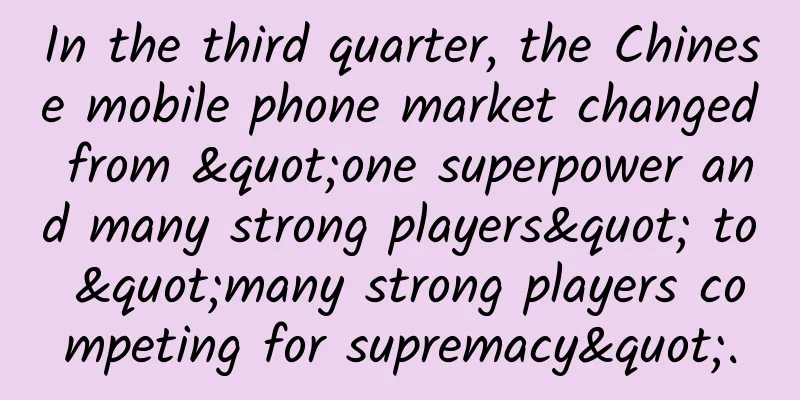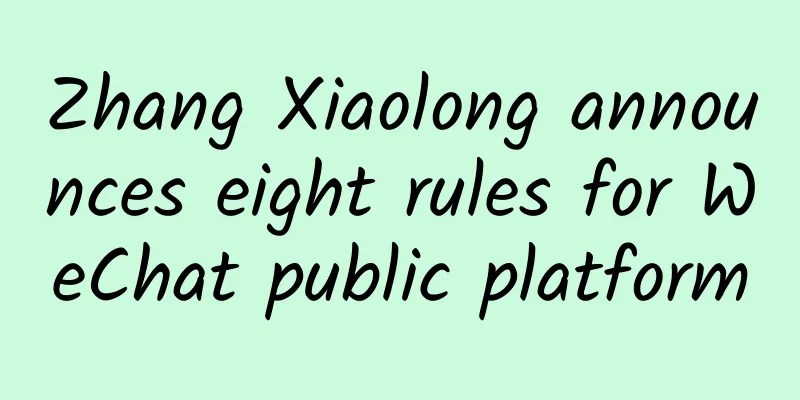Marketing promotion: a few things about brand boundaries

|
Brand boundaries are an important concept in marketing and promotion work. Understanding brand boundaries can help make products more competitive. What are brand boundaries? How to build and break? This article will analyze from three aspects, I hope it will be helpful to you. The first time I became aware of brand boundaries was when I was reading the book "Behind the Products - Creating Breakthrough Product Thinking". In fact, I have had similar feelings when I encountered some related brand positioning issues at work before. When I saw this word this time, a light bulb went off in my mind. It turns out that this phenomenon is called "brand boundary." 1. What is a brand boundary?First of all, we all know that brand refers to the degree of consumer awareness of products and product lines. So what are brand boundaries? Brand boundaries are similar to brand positioning, with the characteristics of personalization, uniqueness, and specialization. They gain higher competitiveness by occupying the minds of users. In psychology, mind refers to the sum of people's abilities to precipitate and store known things and realize motivation through biological reactions. In the book "Behind the Scenes of the Product" it says:
That is, once the brand boundaries are clearly established, it will be very difficult to try to break this boundary later. When I see this sentence, I think of a series of situations I encounter in my current work, and I also have a deeper understanding of the term brand boundary. 2. Establishing Brand BoundariesFor Internet products, the establishment of brand boundaries helps users find a sense of participation and belonging, for example:
Taking Bilibili as an example, the initial creation and dissemination of animation and two-dimensional elements successfully connected content creators and audiences, and transformed the content produced by mass media into new content and culture through self-creation, forming a good content ecology. On this basis, Bilibili did not use advertising, a monetization method commonly used by video sites. There are no patch ads, and most of the content is user-generated. Bilibili's strategy has greatly improved the user experience, and the unique user experience and community atmosphere make Bilibili's user stickiness far greater than other similar software. As a result, Bilibili has been able to stand out from online video sites. It can be seen that under such unique and clearly targeted brand publicity and promotion, the target users are highly active in participating, which stimulates the product to form a unique user culture, and is conducive to the external promotion and recognition of the brand, forming a virtuous circle; Once the brand occupies the minds of users, the product will form a natural barrier in the minds of users and quickly ferment and expand among similar groups. You may ask, how long does it take to establish this brand boundary? The answer is: it can be long or short.
3. Breaking Brand BoundariesYou may find it strange that why do we have to break the brand boundaries when we have just established them? Taking the product of the company I currently work for as an example, the product has been on the market for 5 years and is mainly a part-time job information platform for college students. Under the influence of this year's epidemic, universities are not open, the cost of recruiting for companies has shrunk sharply, the information between the C-end and the B-end is asymmetric, and profits have also declined. When faced with difficulties, the company has launched an online campus recruitment business, trying to explore new business directions and expand its business model. But in the process of advancing the project, we can find out how deeply brand boundaries restrict products. Since the main product was mainly based on part-time job information when it was first established, external publicity and promotion, and the target audience were all mainly part-time workers. Such brand positioning brought benefits to the early user expansion and commercialization of the product. Due to the accurate positioning, companies are also willing to invest. In the past few years, the company has also tried to launch full-time recruitment products, but there has been no improvement. Also, because the main business products are still profitable, the full-time product is on the margins within the company. In the online campus recruitment business launched during this difficult time, I clearly felt the difficulty of product expansion. 1. DistrustA sales colleague gave feedback after expanding customer base: the company has no trust in the product. In the minds of customers, the company's brand positioning has always been a part-time product, while campus recruitment tends to be full-time recruitment. Even though we have a large number of college students, companies are unwilling to invest in our platform. Even if they do, they recruit positions that are not very suitable for their majors, such as sales and management trainees. 2. Misalignment between users and needsWhen the online campus recruitment project was first established, it was promoted through the main product. In this regard, there was a mismatch between users and demand. The users of part-time products tend to be in lower grades. Even college students, who are in their senior year and are about to find a job, rarely take part-time jobs. Therefore, when C-end users open the APP, even if they see the content of campus recruitment, they do not meet the recruitment requirements of B-end companies and cannot sign up. Even if users are in their senior year, their enthusiasm for signing up is not high due to the limitations of job information mentioned in the previous point. Why does this happen? The reason lies in the issue of brand boundaries. No matter which end the users are on, they already have a clear definition and barrier of the brand boundaries of the platform. When we aggressively expand the boundaries of the existing user groups, it is easy to rebound. This is also the problem that Bilibili has encountered in the process of continuously expanding its user groups beyond the two-dimensional world in the past two years. Old users are lost, and new users cannot be retained... 3. So, what is the best way to break this brand boundary?Here are some of my ideas, some of which are still being tested: Slow transformation: This is the safest method. By subtly providing users with more choices through product content, functions and information, when a certain accumulation is reached, transformation can be achieved; the cost of trial and error is also extremely low, problems can be discovered at an early stage and direction can be adjusted in a timely manner. The use of this method requires consistent breakthrough ideas within the company and a willingness to invest resources in transformation. Otherwise, it is very easy for the transformation project to be terminated due to poor internal communication. Change brand promotion channels: This method is more commonly used in the launch of new products. For example, our subsequent online campus recruitment products will be promoted and advertised through new channels, and in order to distinguish them from the main business products, special credit endorsement for campus recruitment is also required. If the subsequent results are good, I will continue to post articles. Marketing out of the circle: This method is similar to the first one, but more radical. For example, in the past two years, we have seen brands cross over and break out of the industry: Wangzai Jeans fashion, Coca-Cola cosmetics, and so on... Many brands expand their popularity and influence through brand marketing by riding on hot topics, cross-border collaborations, and opening pop-up stores. Some of the marketing is so popular that they even topped the hot topic list. This kind of marketing method is actually sowing seeds in the user's mind. When the product bears fruit, the user's mind will be re-established. IV. ConclusionThrough the work on new business during this period, I have been exposed to more knowledge and information about brand positioning, marketing, etc., and I have also learned about the role and limitations of brand positioning in different stages of the product. If I just abandon the brand rashly or cling to the old brand, it will not be beneficial to the development of the product. This article also contains some rough thoughts when I encountered the issue of brand boundaries at work recently. I believe there must be more ways to break brand boundaries, and I hope to discuss them with you. Author: DHAllison Source: DHAllison |
<<: Community group buying from 0 to 1 practical operation notes
>>: Tik Tok Product Analysis Report
Recommend
Intel Launches New SoC Solution to Dramatically Reduce Costs and Accelerate Electric Vehicle Innovation
Innovative OLEA U310 SoC simplifies motor technol...
83.2 meters! The tallest in China! Can trees achieve "immortality"?
recently Two records for trees were broken First,...
Why can’t Sogou’s bidding consumption be displayed even though there is sufficient balance?
Check the ad's enabled status, plan, unit, ke...
Ginkgo biloba actually has no fruit! So what is that stinky fruit you eat?
Audit expert: Wang Guoyi Postdoctoral fellow in N...
Chinese car companies are entering the heart of Europe. The German Chancellor encourages car companies: Don't be scared
Recently, the International Automotive and Smart ...
Kuaigou Taxi's customer base tripled, was the brand name change a success?
Do you still remember Kuaigou Taxi, which grabbed...
Samsung Exynos 8895 vs. Qualcomm Snapdragon 835, which flagship chip do you prefer?
With the official announcement of Samsung's n...
Tips and algorithms for creating popular short videos!
01 Changes in the communication model: from manua...
In 5 days, WeChat will ban this behavior
As a "cosmic center", WeChat has always...
Google search guru Manber leaves
[[127749]] The Wall Street Journal has just revea...
Learn ballet from scratch and gain perfect posture and noble temperament
1. All-round and three-dimensional teaching: from...
Analysis of Estee Lauder’s Double 11 marketing strategy!
In the fiercely competitive beauty industry, majo...
How can you quickly achieve results for a new SEM promotion account?
When you don't know an industry and take over...
In fact, everyone is "love-brained"?
Love is sweet and makes people yearn for it, but ...
iOS source code download: ActionSheet effect imitating QQ Music
Functional classification: Special effects Suppor...









